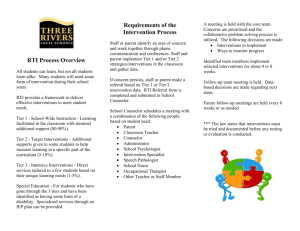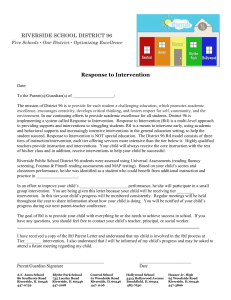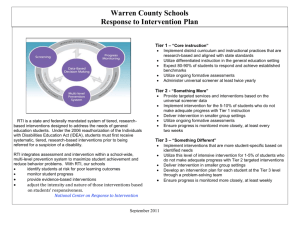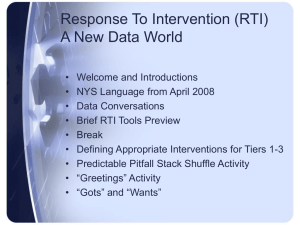RTI Reflection
advertisement
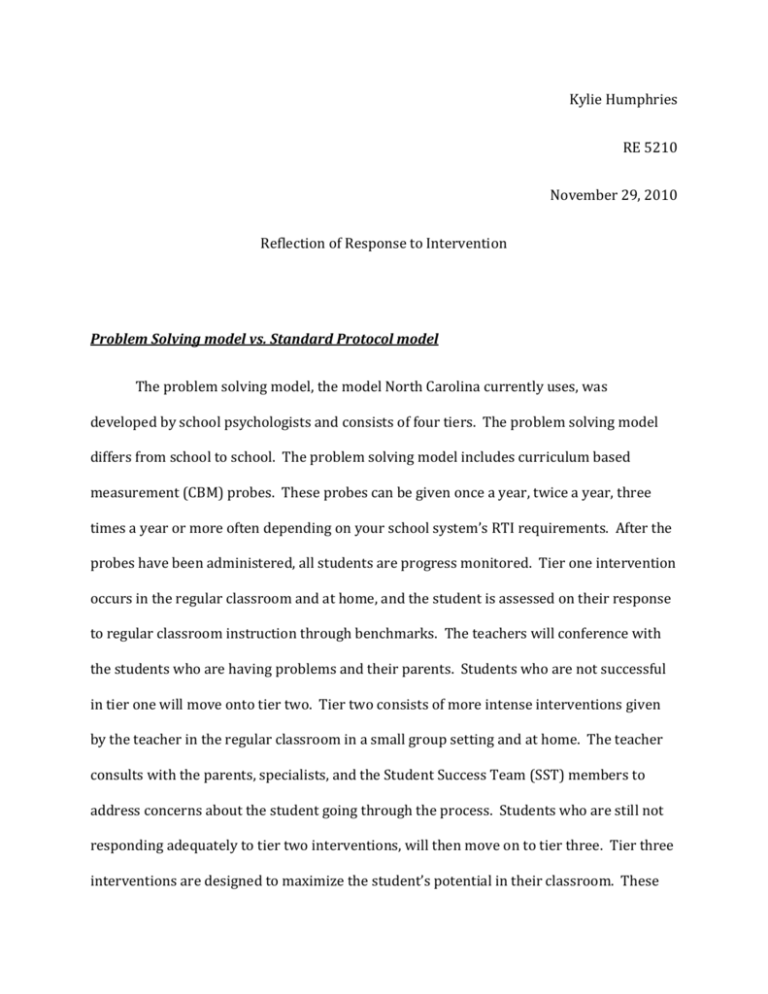
Kylie Humphries RE 5210 November 29, 2010 Reflection of Response to Intervention Problem Solving model vs. Standard Protocol model The problem solving model, the model North Carolina currently uses, was developed by school psychologists and consists of four tiers. The problem solving model differs from school to school. The problem solving model includes curriculum based measurement (CBM) probes. These probes can be given once a year, twice a year, three times a year or more often depending on your school system’s RTI requirements. After the probes have been administered, all students are progress monitored. Tier one intervention occurs in the regular classroom and at home, and the student is assessed on their response to regular classroom instruction through benchmarks. The teachers will conference with the students who are having problems and their parents. Students who are not successful in tier one will move onto tier two. Tier two consists of more intense interventions given by the teacher in the regular classroom in a small group setting and at home. The teacher consults with the parents, specialists, and the Student Success Team (SST) members to address concerns about the student going through the process. Students who are still not responding adequately to tier two interventions, will then move on to tier three. Tier three interventions are designed to maximize the student’s potential in their classroom. These interventions are given by the teacher in the regular classroom in a small group and or pull-out setting and at home. If a student is still not responding successfully to these interventions, then they move on to tier four where they receive more individualized pullout assistance and then are considered for special education services. The problem solving model does not use a standardized cognitive assessment for special education placement, and it is used for all 13 disability areas. The standard protocol model was developed by reading researchers and consists of three tiers. In tier one, all students are screened in the regular classroom by the teacher but only students who scored below average on the screening are progress monitored. Students that scored below average on the screening, and are not making progress, move on to tier two. Tier two consists of at least 30 minutes of intense instruction per day given to a small group (three to six students) outside of the regular classroom setting by a reading specialist. The students’ response to this intervention is assessed through progress monitoring. The standard protocol model holds teachers and other qualified staff accountable for the quality of their instruction through fidelity checks. Fidelity checks are where reading experts come into the classrooms and advise teachers on ways to make their instruction more effective. If a student is still not making sufficient progress, they are then tested to see if they are eligible for special education services. Tier three is where students enter into the special education program. The standard protocol model uses non-response data that is supplemented with cognitive assessments and it is only used to label students “learning disabled” or LD. Both RTI models are multi-tiered systems and students are identified for special education due to non-response to intervention. My Opinion and What We Can Do The goals of RTI are to identify students who are struggling as early as possible and identify students who have disabilities. I personally do not think the problem solving model is the most successful way to identify students who have special needs. I have been teaching for three years, and in those three years I have heard colleagues voice their confusion about which interventions to use, which students should be going through the process, and concerns about whether they are following the process correctly. In my county, each school does RTI differently, so this adds to the confusion. I see students who have “fallen through the cracks” because their teacher does not want to deal with all of the paperwork involved and/or because they have switched schools and their new teacher does not know where to start that student in the process. As educators, we have a small period of time where we are given the opportunity to help children and we cannot afford to waste any of that time. I think the problem solving model is frustrating for teachers and students as well. A reservation I have about the problem solving model is that there are many students who have special needs however they do not qualify for special education and therefore, according to this model, they are thrust back into the regular classroom. These students’ needs are still not being met, and therefore we are not solving the problem. At least with the standard protocol model students, like I mentioned above, stay in tier two and continue to get the intense instruction they need in order to be successful. I think the problem solving model of RTI is not meeting the needs of all students. Students who go through all three tiers and are still not responding to the interventions are not being placed in special education because of their scores on the eligibility test. There is also a large amount of paperwork involved in this process, and this would hinder some teachers from beginning the process altogether. So it would be more practical to lessen the amount of paperwork and simplify the process to make it more “teacher-friendly”. Parents are reluctant to allow their child to enter the RTI process because they view special education negatively. As an educator, I feel that it is part of my job to educate parents on the importance of special education in our schools, and if their child qualifies for special services that does not mean their child is unintelligent or will not succeed. I believe we should meet the child where they are academically, but we must begin intervening early, as early as Kindergarten. In my professional opinion, North Carolina should adopt a model similar to the standard protocol model developed by Fuchs, Fuchs, and Vaughn. For RTI to be successful, teachers need a universal protocol to follow which would solve the problem of students who may move from one school to another. With a universal protocol the student would continue with the same level of intervention at their new school, and no time would be wasted on repeating old interventions. At my school, we have Kindergarten and 1st grade assistants, tutors, gateway tutors, special area teachers, and a Title 1 reading specialist that could help with small group interventions. Obviously not all of these staff members are highly qualified to teach reading, therefore I would suggest that they receive weekly afterschool training sessions from a qualified reading specialist and meet regularly with classroom teachers to discuss data. To make the problem solving model beneficial I think there should be a simple, standard protocol used throughout the school, district, and state, teachers and other faculty members should share data on a regular basis and help one another, and ensure students are given quality instruction in the regular classroom and in small group settings. Some academically delayed children, if given intense small group/individual interventions would catch right back up with their peers, and those students who did not respond adequately would continue the intense interventions until further decisions could be made based on what is best for that individual student. I currently have a student in my 4th grade classroom that completed all three tiers of the problem solving RTI model in 3rd grade for math. At the end of the third tier however, the school psychologist and the principal decided she had made enough progress and she did not qualify for special education services. So she was promoted to 4th grade and continues to struggle greatly in math. I was told I should possibly start the process over again, but I am not sure if that would make any difference. I believe she would benefit from an extra thirty minutes to an hour of intense math instruction every day, but this is something I am not physically able to give her. I am not making excuses for myself, I do my best each day to give quality instruction to all of my students, although I know what I offer is still not enough for some of them. That fact is what is most frustrating for me and my colleagues. The idea of RTI is wonderful but teachers do not have the resources, materials, or the authority to make it most beneficial to students.



